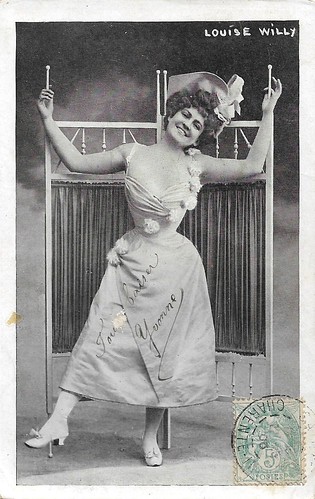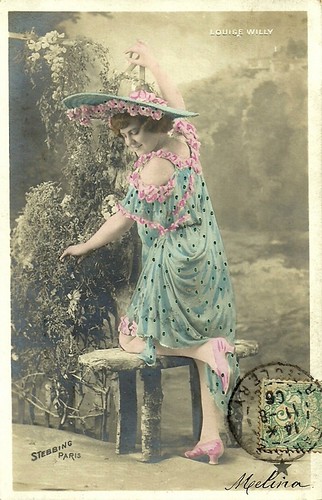
French postcard. Photo: Ogerau. Caption: "Willy, vaudeville". Louise Willy, probably in 'Le Coucher de la mariée/Le Coucher d'Yvette', a stage play turned in 1896 into the first striptease film.

Vintage French postcard. Louise Willy in 'Le Coucher de la mariée' (The Bridegroom's Dilemma).

French postcard. Photo: Stebbing, Paris. Sent by mail in 1906.
Her clothes are seen falling off one by one
Louise Willy was born around 1873. She was a student of the mime Charles Aubert and made her debut at the Théâtre des Nouveautés in 1892, in a small role in 'La Bonne de chez Duval' by Antony Mars and Hippolyte Raymond. Then she appeared at the Théâtre Moderne in 'Tous à la scène' by Victor de Cottens and Paul Gavault. She joined the Folies-Bergères in 1894, in 'Fleur de Lotus', a pantomime by Armand Silvestre and Hugues Delorme. She was then hired at the Olympia and toured Cabourg and Lyon where she replaced Blanche Cavelli at the Eldorado theatre in a tableau from the play 'Le Coucher d'Yvette', also called 'Le Coucher de la mariée', a lyrical pantomime by Francisque Verdellet with music by Eugène Arnaud.
Loulou was engaged at the Jardin de Paris where she played 'Le Suicide de Pierrot', then the role of the Fairy in 'La Fée des poupées', a Viennese ballet-pantomime by Josef Hassreiter and Franz Gaul created at the Olympia in October 1894. In 1895, she appeared in the revue 'Les Turlutaines de l'année' and the pantomime 'Mauvais Rêve' by Max Maurey, music by Rodolphe Berger, and triumphed at the Olympia in 'Le Coucher de la mariée', a pantomime by Gaston Pollonnais and Oscar de Lagoanére, in which her clothes are seen falling off one by one, and in 'Le Bain de la Parisienne'.
In 1896, she appeared in the erotic film Le Coucher de la mariée/The Bridegroom's Dilemma, based on the play of the same name, a film produced by Eugène Pirou and directed by Léar (pseudonym of Albert Kirchner). From the original seven (others claim: three) minutes of the 1896 version, only two minutes survived, including the undressing sequence, and were restored in 1996, a century after.
In Le Coucher de la mariée, we see a newly-wed couple in front of the wedding bed, in sequence and full-length shot. Returning from the wedding, the husband (Frédéric Berville) raves about his wife (Willy), who is simpering. She asks him to withdraw while she undresses. He puts a screen between her and himself. She removes one by one the many garments she is wearing (jacket, dress, petticoats, underskirts, bodice). The husband cannot keep still, sometimes sponging his forehead, sometimes reading a newspaper, sometimes casting concupiscent glances over the screen.
The actors make numerous glances at the camera. The film is considered the first striptease in film history. The popularity of the film caused Georges Méliès to do a remake in 1899, while Pathé even did three: in 1901, in 1904 (with Willy herself again), and in 1907. In 1906, Pathé also would make a parody of it, called Au revoir et merci! Indeed, from the late 1890s, because of the success of Le Coucher de la mariée, Pathé developed a genre called 'scènes grivoises d'un caractère piquant'.

French postcard. Photo: Stebbing, Paris.

French postcard by Papier Guilleminot, series no. 770, Th 71. Photo: Stebbing, Paris. Sent by mail in 1905.
A girl who undresses, searching for a flea
In 1897, Louise Willy created the role of Églantine in the ballet-pantomime 'Le Chevalier aux fleurs' by Armand Silvestre, music by André Messager and Raoul Pugno, at the Théâtre Marigny. Back at the Olympia, in 1898, she played in a revival of 'Le Coucher de la mariée'and also in 'Pierrot cambrioleur', 'Vision!' a ballet-pantomime by Léon Roger-Millès to the music of Edmond Missa. She also played in 'Folles Amours', 'Néron' with Émilienne d'Alençon, and as Pierrette in 'Les Sept Péchés capitaux' by Maurice de Marsan to the music of Henri Hirschman, as well as in the ballet-féerie 'Les Mille et Une Nuits' by Max Maurey and A. Thierry in 1899.
She appeared at the Parisiana in 1900 in a revival of 'Mauvais Rêve', at the Olympia in 'La Belle aux cheveux d'or', a ballet-pantomime by Jean Lorrain, with music by Edmond Diet. She created the role of Julie in 'Moins cinq!', a play by Paul Gavault and Georges Berr, performed at the Palais-Royal, in November 1900. In April 1901, Willy created the role of Gabrielle Vernis in the comedy 'Sacré Léonce!' by Pierre Wolff.
Willy then left the theatre to return to the music hall with roles in 'Paris-Cascades', a ballet by Auguste Germain to the music of Louis Varney at the Olympia in September 1901, and in 'Cendrillon', a fairy-tale-ballet by Alphonse Lemonnier and Gardel Hervé to music by Victor Rogeren in 1902. At La Scala, she played 'Cambriolage' by Jacques Lemaire and Paul Fauchey in October 1902. In 1903, she was hired at the Mathurins Theatre. She played 'La Momie', a pantomime by Henry Ferrare and Louis Aubert, and the role of Laurida in 'Cœur jaloux', a pantomime by Henri Reine, with music by Chantrier.
In 1904, she played Prince Aurore in the Folies-Bergères revue by Victor de Cottens, and Praxiteles in 'Phry(g)né' with Cléo de Mérode at the Olympia. In 1905, she played in 'Pris au piège', a play by Théo, music by H. Rosès at the Théâtre des Capucines. In 1906, she was in 'Josiane Eymard', a play by Jean Lorrain at the Nouvelle-Comédie. René Debrenne hired her for the provincial tour to play the role of Cléo de Garches in 'Amour et Cie' by Louis Forest. In 1907, she created the role of Delphine in 'La Lime', a mimodrama by Henry Ferrare, music by André Fijan, at the Moulin-Rouge on 23 April, which she performed again at the Palais des Beaux-Arts in Monte Carlo in 1909. Finally, all trace of her is lost after the release of her last film L'Homme nu in 1913. She must have been about 40 years old at the time.
From 1904, Willy did various films at Pathé Frères, starting with the risqué film La puce/The Flea (Albert Capellani, 1904), about a girl who undresses, searching for a flea, as well as a remake of Le Coucher de la mariée. IMDb claims Willy was also in the 1906 films Aladin ou la lampe merveilleuse and La femme du lutteur, but the Pathé website denies this. For sure, Willy acted in two comedies of 1909: the Prince comedies Le dîner du 9 (Georges Monca, 1909) and La vengeance du chauffeur (dir. unknown, 1909). In 1911-1913 she acted in three films by Henri Desfontaines: Falstaff (1911) with Françoise Rosay, Le page (1912) with Madeleine Céliat, and L'homme nu/The Hollow Man (1913) with Raimu, her last film. The first two were for Eclipse, and the third for Pathé (although the Pathé site doesn't list this film).



No comments:
Post a Comment